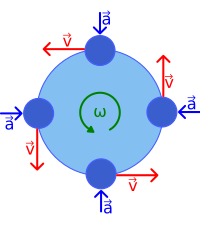User:Inconspicuum/Physics (A Level)/Circular Motion

Very rarely, things move in circles. Some planets move in roughly circular orbits. A conker on a string might move around my head in a circle. A car turning a corner might, briefly, move along the arc of a circle. The key thing to note about circular motion is that there is no force pulling outwards from the circle, and there is no force pulling the moving object tangential to the circle. Centrifugal force does not exist. There is only one force acting in circular motion, which is known as centripetal force. It always acts towards the centre of the circle. The object does not follow a circular path because two forces are balanced. Instead, the centripetal force accelerates the object with a constant magnitude in an ever-changing direction. The object has a velocity, and will continue moving with this velocity unless acted on by the centripetal force, which is perpetually adding velocity towards the centre of the circle.
If you were to subject a stationary object to the centripetal force, it would simply fall. If you gave it a little bit of velocity, it would still fall, but it would not land directly beneath its starting position. If you kept increasing the velocity and dropping it, there would come a point when it would land infinitely far away - it would go into orbit. The relationship between this 'magic' velocity and the magnitude of the centripetal force is as follows:
,
where m is the mass of the object in circular motion, v is the magnitude of its velocity, and r is the distance from the centre of the circle to the object. Since F=ma, the centripetal acceleration is:
The centripetal force may manifest itself as many things: the tension in a string, friction, gravity or even an electric or magnetic field. In all these cases we can equate the equation for centripetal force with the equation for the force it really is.
Angular Velocity
editVelocity is the rate of change of displacement. Angular velocity is the rate of change of angle, commonly denoted ω and measured in radians per. second:
In circular motion:
,
where T is the time for one revolution and f is the frequency of rotation. However:
Therefore, the relationship between velocity and angular velocity is:
If we substitute this into the formula for centripetal acceleration:

